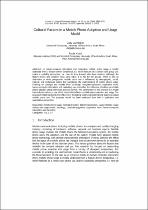JavaScript is disabled for your browser. Some features of this site may not work without it.
- ResearchSpace
- →
- Research Publications/Outputs
- →
- Journal Articles
- →
- View Item
| dc.contributor.author |
Van Biljon, J

|
|
| dc.contributor.author |
Kotzé, Paula

|
|
| dc.date.accessioned | 2009-02-12T10:55:32Z | |
| dc.date.available | 2009-02-12T10:55:32Z | |
| dc.date.issued | 2008 | |
| dc.identifier.citation | Van Biljon, J and Kotze, P. 2008. Cultural factors in a mobile phone adoption and usage model. Journal of Universal Computer Science. vol 14(16), pp 2650-2679 | en |
| dc.identifier.issn | 0948-695X | |
| dc.identifier.uri | http://www.jucs.org/jucs_14_16 | |
| dc.identifier.uri | http://hdl.handle.net/10204/2984 | |
| dc.description | Copyright: 2008 J.UCS | en |
| dc.description.abstract | In human-computer interaction and computing, mobile phone usage is mostly addressed from a feature-driven perspective, i.e. which features do a certain user group use, and/or a usability perspective, i.e. how do they interact with these features. Although the feature driven and usability focus carry value, it is not the full picture. There is also an alternative or wider perspective: mobile phone use is influenced by demographic, social, cultural, and contextual factors that complicate the understanding of mobile phone usage. Drawing on concepts and models from sociology, computer-supported cooperative work, human-computer interaction and marketing, we researched the influence of culture on mobile phone adoption using interviews and two surveys. The contribution of this research is a model that includes culture as one of the factors that influence mobile phone adoption and usage. The proposed model represents the influence of mediating factors and determining factors on actual mobile phone use. The proposed model has been evaluated from both a qualitative and quantitative perspective. | en |
| dc.language.iso | en | en |
| dc.publisher | J.UCS | en |
| dc.subject | Mobile phone usage | en |
| dc.subject | Human computer interaction (HCI) | en |
| dc.subject | Usage determination | en |
| dc.subject | Usage intensity | en |
| dc.title | Cultural factors in a mobile phone adoption and usage model | en |
| dc.type | Article | en |
| dc.identifier.apacitation | Van Biljon, J., & Kotzé, P. (2008). Cultural factors in a mobile phone adoption and usage model. http://hdl.handle.net/10204/2984 | en_ZA |
| dc.identifier.chicagocitation | Van Biljon, J, and Paula Kotzé "Cultural factors in a mobile phone adoption and usage model." (2008) http://hdl.handle.net/10204/2984 | en_ZA |
| dc.identifier.vancouvercitation | Van Biljon J, Kotzé P. Cultural factors in a mobile phone adoption and usage model. 2008; http://hdl.handle.net/10204/2984. | en_ZA |
| dc.identifier.ris | TY - Article AU - Van Biljon, J AU - Kotzé, Paula AB - In human-computer interaction and computing, mobile phone usage is mostly addressed from a feature-driven perspective, i.e. which features do a certain user group use, and/or a usability perspective, i.e. how do they interact with these features. Although the feature driven and usability focus carry value, it is not the full picture. There is also an alternative or wider perspective: mobile phone use is influenced by demographic, social, cultural, and contextual factors that complicate the understanding of mobile phone usage. Drawing on concepts and models from sociology, computer-supported cooperative work, human-computer interaction and marketing, we researched the influence of culture on mobile phone adoption using interviews and two surveys. The contribution of this research is a model that includes culture as one of the factors that influence mobile phone adoption and usage. The proposed model represents the influence of mediating factors and determining factors on actual mobile phone use. The proposed model has been evaluated from both a qualitative and quantitative perspective. DA - 2008 DB - ResearchSpace DP - CSIR KW - Mobile phone usage KW - Human computer interaction (HCI) KW - Usage determination KW - Usage intensity LK - https://researchspace.csir.co.za PY - 2008 SM - 0948-695X T1 - Cultural factors in a mobile phone adoption and usage model TI - Cultural factors in a mobile phone adoption and usage model UR - http://hdl.handle.net/10204/2984 ER - | en_ZA |






